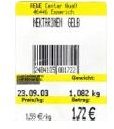The Cost of Goods Sold Formula: Understanding COGS and Its Sub-Components
Cost of Goods Sold or COGS, is an income statement component, representing the basic cost of the products sold by a merchandising entity during the year. The standard COGS formula is a way of determining the costs attributable to the products sold, after determining how much of the inventory stocks are still on hand.
It is quite important that the values used to fill in the formula should be as accurate as possible since COGS is the first item deducted from the year’s total sales in order to disclose the Gross Profit. The guiding accounting principle is to match real expenditure against actual revenue wherein the Cost of Goods Sold is the most significant outlay to consider.
Based on the Gross Profit amount, the analyst of the Income Statement can immediately assess if the retail business is selling within a comfortable gross profit margin, in order to realize a return on investments from the products being sold. A relatively low amount of gross profit means the retail activity has very little room to realize a bottom-line net income; that is, after all other operating expenses have been considered and deducted.
In explaining the Cost of Goods Sold formula, the reader will come to know how inventory costing methods and the physical inventory procedures play significant roles in establishing the values used.
The COGS Formula
The basic Cost of Goods Sold formula is:
Cost of Goods Sold (COGS) = Beginning Inventory + Inventory Purchases - End Inventory
Breaking down this formula, piece by piece, we have:
Merchandise Inventory, Beginning
+ Purchases
= Total Cost of Goods Available for Sale
– Merchandise Inventory, End
= Total Cost of Goods Sold
Here are the guidelines for determining the values assigned for each of the COGS sub-components:
Merchandise Inventory Beginning

The Merchandise Inventory, Beginning for the year is the Merchandise Inventory, End of the preceding year. This is presented in the balance sheet financial report and merely forwarded as the initial entry of the succeeding year’s general ledger Merchandise Inventory account. In addition, the method of recording transactions for this general ledger account will depend on the type of inventory method used.
If the periodic inventory method is used, the actual count of the stocks on hand will be the basis in determining the amount of the year-end merchandise inventory balance. Once the actual physical inventory as of cut-off date has been established, the Merchandise Inventory beginning entry will be zeroed out while the actual inventory amount becomes the new balance. There will be adjusting and post-closing accounting entries to bring the Merchandise Inventory account equivalent to the actual value of stock inventory held on hand as of cut-off date. This is how the Merchandise Inventory, Beginning, for the new cycle is determined.
Purchases
Under the periodic inventory method, goods bought as additional stocks during the year of operation are recorded under the Purchases account. This is a temporary account used in accounting for all stock replenishments during the year. In the COGS formula, the total purchases recorded under this general ledger account will be the value added to the Merchandise Inventory, Beginning. Their sum represents the entire value of the goods that were available for sale during the year.
The Purchases account will also receive much scrutiny since the issue of over-stocking may crop up if the year-end inventory will reveal a substantial amount of stocks held on hand. This means that the system used in monitoring stock levels will have to be reviewed. The purchase costs and the costing methods will greatly impact the amount that will be established as value of the year end merchandise inventory.
It is possible that products purchased for resale may have increased or decreased in prices; hence, the Purchases account should serve as a reliable reference for apportioning the cost recognized as cost of good sold. A separate discussion of Different Inventory Costing Methods will show the relevance of the Purchase account in establishing the value of the stocks on hand.
In relation to purchase prices, any trade discounts or reduction in prices are not recognized as a separate transaction. Procurement will simply be recorded at the cost paid for by the business entity; the effects of the discounted price will be recognized accordingly in the inventory costing method used. In some cases, if the purchase discount is granted as a result of prompt credit payment, the discount will be merely recognized as a reduction of the liability and of the purchase cost.
Merchandise Inventory, End


The Merchandise Inventory, End is the overall value of the actual inventory stocks held on hand and physically accounted for, after conducting thorough physical inventory procedures.
In a computerized business environment, the accuracy of the results of actual physical counting can be tested against computer generated records of individual inventory stock listings. In retail operations, each piece of merchandise bought at the store is automatically deducted against the individual inventory list, every time the cashier enters the barcode as an item sold in a computerized business machine. This type of inventory method is called perpetual inventory.
Hence, computer generated inventory records can furnish ready references of the stock levels, used as basis for requiring stock replenishments. At year end, the quantity of stock inventory for every product being sold, as disclosed by a computerized system of recording inventory movements, will be verified upon physical inventory count.
Any resulting difference will have to be investigated for possible errors or pilferage. A computer generated list that shows higher figures may be construed as unauthorized or unaccounted removal of stocks since there are no corresponding sales entries taken-up by the computerized cash register.
On the other hand, if the physical inventory reveals a greater number than the computer generated inventory list, it is possible that some purchases were not properly recorded in the Purchases or Merchandise Inventory account. The results of investigations as well as management’s recommendations, will dictate how the inventory differences will be taken-up in the books of accounts. This is a critical point in determining the actual value of Merchandise Inventory, End as a sub-component of the Cost of Goods Sold formula.
The periodic inventory method of the actual merchandise on hand is conducted as of a specific cut-off date, which is usually at year-end. This is to determine how much of the inventory stocks carried over from the previous year plus the procurements made during the year still remains in the warehouse. The accounting entry should carefully consider the costs assigned to the inventory, since the effect will be carried over to the succeeding year of operation.
In further explaining the Cost of Goods Sold formula, its related accounting entries and their effects in the general ledger books, the reader may further refer to a separate article entitled Examples of T Accounts, which made use of this particular topic as example.
Reference Material and Images Credit Section
Reference Materials:
- https://www.answers.com/topic/perpetual-inventory-system
- https://taxguide.completetax.com/text/c60s15d150.asp
- https://www.reallifeaccounting.com/pubs/Article_Theme_Accounting_for_Inventory.pdf
- https://www.investorwords.com/1158/Cost_Of_Goods_Sold.html
- https://www.principlesofaccounting.com/chapter%205.htm.
Images Credit:
- Wikimedia Commons
